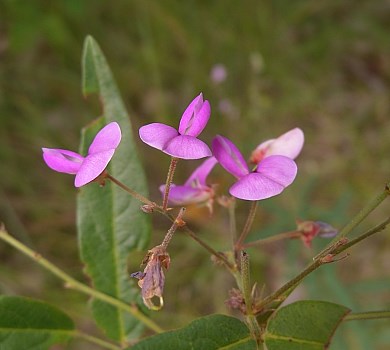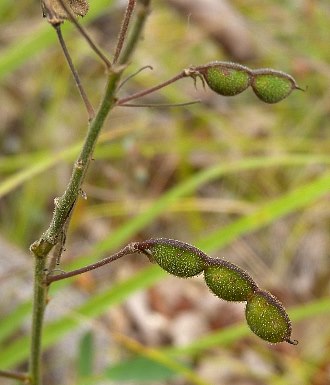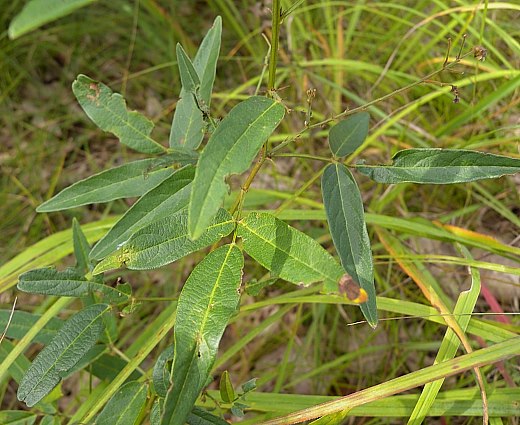Description: This perennial wildflower is 2–3½' tall, sometimes branching in the upper half. The stems are light green and usually hairless; however, some variants of this species have pubescent stems. Alternate compound leaves occur at intervals along the stems; they are trifoliate and their leaflets are extended horizontally in relation to the ground. Individual leaflets are up to 3½" long and ¾" across; they are 3-6 times as long as they are wide. Some variants of this species have more narrow leaflets than others. The terminal leaflet is the same length or a little longer than the lateral leaflets. The leaflets are elliptic to oblong in shape and smooth along their margins. Their upper surfaces are medium green and glabrous, while their lower surfaces are pale to medium green and covered with appressed white hairs. The petioles of the compound leaves are up to 2" long, light green, and mostly hairless. At the base of each petiole, there is a pair of tiny deciduous stipules that are linear-lanceolate; these stipules soon wither away. The petiolules (secondary petioles) of the lateral leaflets are very short (less than 1/8" or 3 mm.), while the petiolules of the terminal leaflets are longer (up to ½").

The upper stems
terminate in either racemes or narrow panicles of flowers. The branches
of each inflorescence are light green and covered with hooked hairs.
Individual flowers are ¼" long (or a little more), consisting of 5
petals, a short tubular calyx with teeth, an ovary with a single style,
and several hidden stamens. The flowers have a typical pea-like
structure, consisting of an upright banner and 2 lateral wings that
enclose a central keel. The petals are pink to rosy pink; at the base
of the upper petal (banner), there are 1-2 tiny patches of yellow. The
green calyx is covered with hooked hairs. The slender petioles of the
flowers are about ½" long; they are green to reddish purple and also
covered with hooked hairs. The blooming period occurs from mid-summer
to early fall and lasts about 1–1½ months. There is no noticeable
floral scent. Fertile flowers are replaced by flat loments (a type of
seedpod) that are about ½–1½" long. Each loment consists of 2-6 rounded
segments, a short stipe, and sometimes a short beak. Each segment of a
loment is more rounded along the bottom than along the top; it contains
a single seed. The loments are covered with hooked hairs. The root
system consists of an elongated caudex with fibrous roots. This
wildflower spreads by reseeding itself.
Cultivation:
The preference is partial sun, mesic to dry-mesic conditions, and sandy
or rocky soil.

Range & Habitat:
The native Panicled Tick Trefoil is occasional in all areas of
Illinois, except
the NW section, where it is rare or absent (see Distribution
Map). Habitats consist of thinly wooded bluffs, rocky open
woodlands, sandy open woodlands, sandy savannas and typical savannas,
woodland edges, thickets, rocky glades, and partially shaded roadside
embankments. This wildflower is a pioneer species that prefers some
disturbance from wildfires, selective logging, and others causes.
Faunal Associations:
Long-tongued bees collect pollen from the flowers; these relatively
uncommon floral visitors include bumblebees (Bombus spp.),
leaf-cutting
bees (Megachile spp.),
and long-horned bees (Melissodes
spp.). Other insects
feed on the leaves, flowers, and seeds of Desmodium spp.
(Tick Trefoils). For example, the caterpillars of several skippers feed
on the leaves: Achalarus lyciades (Hoary Edge), Epargyreus
clarus (Silver-Spotted Skipper), Thorybes bathyllus
(Southern Cloudywing), and Thorybes pylades
(Northern Cloudywing). The caterpillars of the butterfly Everes
comyntas (Eastern Tailed Blue) also feed on the foliage,
while the caterpillars of the butterfly Strymon melinus
(Gray Hairstreak) eat the flowers and developing seedpods. Other insect
feeders include primitive weevils, leaf beetles, larvae of gall flies,
larvae of leaf-blotch miner moths (Gracillariidae), aphids, thrips, and
grasshoppers (see the Insect Table for a more complete and detailed listing of these species). The seeds are eaten by some upland gamebirds
(Bobwhite Quail, Wild Turkey) and small rodents (White-Footed Mouse,
Deer Mouse), while the foliage is readily eaten by White-Tailed Deer
and other hoofed mammalian herbivores. The Cottontail Rabbit also
consumes the foliage. The sticky seedpods (loments) cling to the fur of
animals and the clothing of humans. As a result, the seeds are carried
to new locations.

Photographic
Location:
A sandy savanna at Hooper Branch Savanna Nature Preserve in Iroquois
County, Illinois.
Comments:
Among different populations of Panicled Tick Trefoil, there is
significant variation in the width of the leaflets and the hairiness of
the stems and leaflets. Usually, this wildflower has fairly narrow
leaflets, hairless to nearly hairless stems, and hairless upper
surfaces on the leaflets. It can be distinguished from other species in
this genus by considering the following key characteristics: 1) the
narrow leaflets are 3-6 times longer than they are across, 2) the
petioles of the trifoliate leaves are fairly long (up to 2"), 3) the
deciduous stipules of the trifoliate leaves are small and
insignificant, and 4) the leaflets are rather long (up to 3½").
Panicled Tick Trefoil is one of the more common species of this genus
in Illinois.